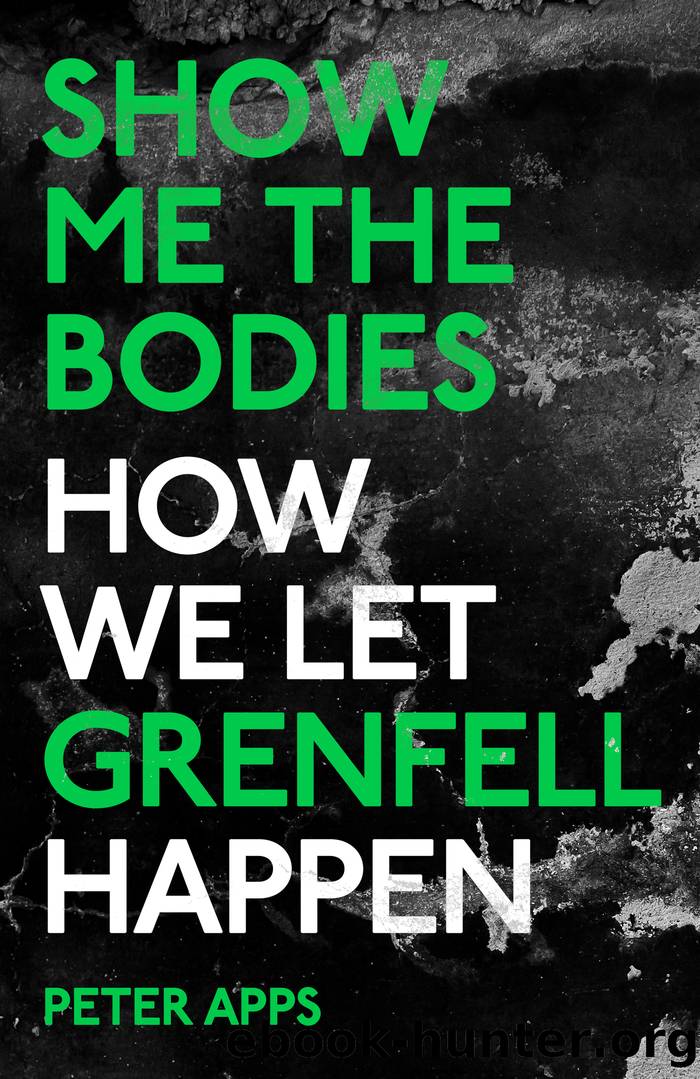Show Me the Bodies by Peter Apps

Author:Peter Apps
Language: eng
Format: epub
ISBN: 9780861545957
Publisher: Oneworld Publications
2012
In a bid to achieve what was described as âeconomies of scaleâ, the council sought to appoint the same contractor (Leadbitter) and architect (Studio E) who were working on the new school and leisure centre to refurbish the tower as well.
This was an odd decision. Studio E â which specialised in education â had no experience of this sort of work. Minutes of a 2012 meeting with residents record Eddie Daffarn asking if the architects âhave experience with tower blocks and if not why are we using them?â
This is a question that should have been asked formally. Procurement rules meant the job should have been advertised publicly and given to the winning firm. With its lack of experience, it is very unlikely Studio E would have won this bid. But this work simply did not happen. Instead, the firmâs fee was split in half to avoid the threshold which required a procurement process and the architects were appointed without scrutiny.7
Architect Bruce Sounes was put in charge. It was to be his first high-rise and his first residential cladding project. In 2012, he set about drawing up plans for the towerâs new cladding system. But, according to his own testimony, he did not check the relevant regulations and rules. His view, he explained to the inquiry, was that cladding specialists would be joining the project later on. It would be up to them, he felt, to spot and correct any mistakes.
To recap â at this point Approved Document B required Mr Sounes to choose a Class 0 cladding panel and limited combustibility insulation (in practice, this meant mineral wool), or to use a system which had passed a large-scale test. But alongside consultants Max Fordham, the architects opted to pursue an âaspirationalâ thermal performance for the tower. They wanted to insulate it to the same standard as a new build. As a result, Mr Sounes and the consultants decided Celotex insulation was the only material that would achieve the required performance.* It did not meet the minimum standard of limited combustibility and had not, at this point, passed a test. But Mr Sounes was aware it was widely used in the industry and assumed that it was compliant.
For the cladding, Mr Sounes selected zinc panels. He did not consider their fire performance, but liked the way they looked. Residents were consulted in August 2012 and were told they would be getting âfire-retardantâ cladding.8
It is worth making clear that there were plenty of fire safe options for this job. As well as Mr Sounesâ zinc panels, D+B Facades was asked to cost the provision of solid aluminium sheets for the project which would have been fully non-combustible.9 I have also spoken to a supplier of rendered systems â which would have involved applying non-combustible insulation directly to the walls. But this does not provide the sharp, modern look of a rainscreen system. âThey were favouring the rainscreen cladding system for aesthetic reasons â the thinking was âwe can make these concrete buildings look like shiny new buildingsâ.
Download
This site does not store any files on its server. We only index and link to content provided by other sites. Please contact the content providers to delete copyright contents if any and email us, we'll remove relevant links or contents immediately.
Cecilia; Or, Memoirs of an Heiress — Volume 1 by Fanny Burney(32064)
Cecilia; Or, Memoirs of an Heiress — Volume 3 by Fanny Burney(31459)
Cecilia; Or, Memoirs of an Heiress — Volume 2 by Fanny Burney(31409)
The Great Music City by Andrea Baker(30784)
We're Going to Need More Wine by Gabrielle Union(18636)
All the Missing Girls by Megan Miranda(14748)
Pimp by Iceberg Slim(13781)
Bombshells: Glamour Girls of a Lifetime by Sullivan Steve(13689)
Fifty Shades Freed by E L James(12918)
Talking to Strangers by Malcolm Gladwell(12881)
Norse Mythology by Gaiman Neil(12836)
For the Love of Europe by Rick Steves(11528)
Crazy Rich Asians by Kevin Kwan(8891)
Mindhunter: Inside the FBI's Elite Serial Crime Unit by John E. Douglas & Mark Olshaker(8707)
The Lost Art of Listening by Michael P. Nichols(7165)
Enlightenment Now: The Case for Reason, Science, Humanism, and Progress by Steven Pinker(6877)
The Four Agreements by Don Miguel Ruiz(6322)
Bad Blood by John Carreyrou(6280)
Weapons of Math Destruction by Cathy O'Neil(5837)
